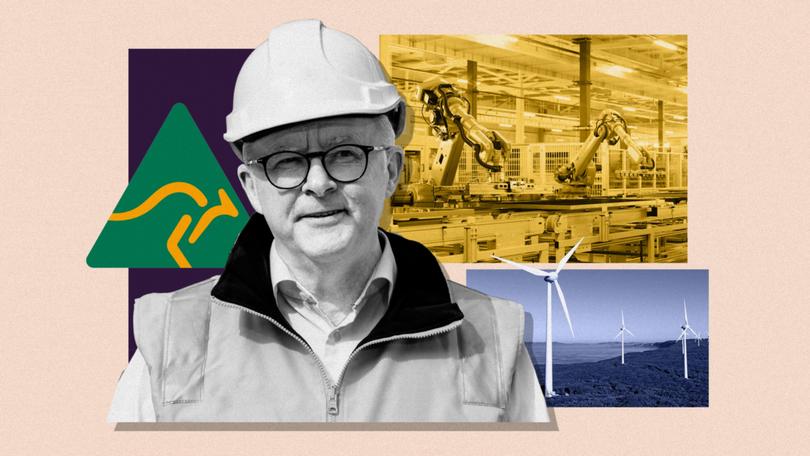Federal Budget 2024: $30.9b of taxpayer-funded sweeteners for critical minerals and green hydrogen players

Australia’s embattled battery metals miners got the tax relief industry lobby groups wanted, but it won’t come as soon as many might have hoped.
Meanwhile, the nascent green hydrogen sector that is being heavily backed by Andrew Forrest, Australia’s richest man, will also be a major recipient of government subsidies.
The Federal Budget handed down on Tuesday has set aside about $13.7 billion of production tax credits for producers of critical minerals and green hydrogen aspirants over the next decade.
Sign up to The Nightly's newsletters.
Get the first look at the digital newspaper, curated daily stories and breaking headlines delivered to your inbox.
By continuing you agree to our Terms and Privacy Policy.The Albanese Government will give producers of designated critical minerals, which includes nickel and lithium, a 10 per cent tax credit per year for up to 10 years per project.
This means for every $100 dollars of eligible production costs the miner’s tax bill will be lowered by $10, or if it did not make enough to pay tax it can still claim a $10 refund.
The critical minerals move has an estimated cost of $17.6b, split between $7.1b from now until the 2034 financial year, and then another $10.6b until 2041.
But the credits will only kick in from July 2027, despite Australia’s nickel industry currently circling the drain.
Minerals Council of Australia chief executive officer Tania Constable welcomed the production tax credits but said they will have “no immediate impact”.
“In light of the Treasurer’s warning about global uncertainty shaping this budget and noting that these credits will have no immediate impact on the budget, the MCA will continue to work with the government and Treasury to better understand the long-term benefits this policy could offer,” she said.
BHP has said it will make a decision on the future fate of its WA nickel arm — which employs some 3300 people across the State — in August, following an onslaught of Indonesian supply pushing prices down.
The closure of BHP’s Kalgoorlie nickel smelter will have adverse flow on impacts for producers of other commodities in the Goldfields region, including Lynas Rare Earths.
The price pain has already forced a number of nickel sites to be mothballed in WA, including the operations owned by Mr Forrest’s Wyloo Metals.
The production tax credit is “for eligible processing and refining costs” , which means locally-based lithium miners like Chris Ellison’s Mineral Resources and Tim Goyder’s Liontown Resources will miss out unless they decide to invest in downstream processing, such as lithium hydroxide plants.
A MinRes spokesman said the company welcomes the government’s announcement.
“This policy will help Australia move further down the battery supply chain to add more value to our critical minerals and create the jobs of the future,” he said.
Big beneficiaries are set to be IGO Limited, China’s Tianqi and the United States’ Albemarle, who all currently have lithium hydroxide operations in WA.
Wesfarmers and Chile’s SQM are planning to be downstream-ready next year for the recently-opened Mt Holland mine.
Wesfarmers chief executive Rob Scott also gave the production tax credits the thumbs up.
“This is smart, targeted use of the tax system to solve big problems, leverage our competitive advantages and enhance Australia’s prosperity,” he said.
The Associated of Mining and Exploration Companies led the charge for the 10 per cent production tax credit, estimating in its own research the scheme would inject an extra 4220 jobs and $1.79b into the economy over the long-term.
AMEC chief executive Warren Pearce said the tax incentive was a zero-risk approach for Australia to take.
“If companies don’t produce a value-added product, they don’t receive a tax credit. It’s as simple as that,” he said.
Chamber of Minerals and Energy of WA chief executive Rebecca Tomkinson said the tax credit move is positive but more needs to be done.
“The production tax credit is important and will play a specific role, but we have always said it’s going to take a holistic package of industry policy and the delivery of factors like reduced project permitting timelines to really move the dial,” she said.
On the green hydrogen front the government will gift a $2 subsidy per kilogram of renewable hydrogen produced between from FY2027 to FY2041, also for up to 10 years per project.
It expects the tax break will set the budget back $6.7b from this year until FY2035 and then a further $6.6b across the final six years.
The government is also expanding the ‘Hydrogen Headstart’ program by $1.3b, which it said in combination with the production incentives would facilitate support for early movers to invest in the sector’s development.
Beyond production tax credits the government has also unveiled the ‘Battery Breakthrough Initiative’, costing $523.2m over seven years to fund “high-value opportunities” in the battery manufacturing supply chain.
It also confirmed the investment of $556.1m across 10 years to progressively map Australia’s natural resources under the soil and seabed.
The government hopes the mapping exercise will provide the scientific information necessary in guiding future investment for the minerals needed to develop renewable energy technologies.
